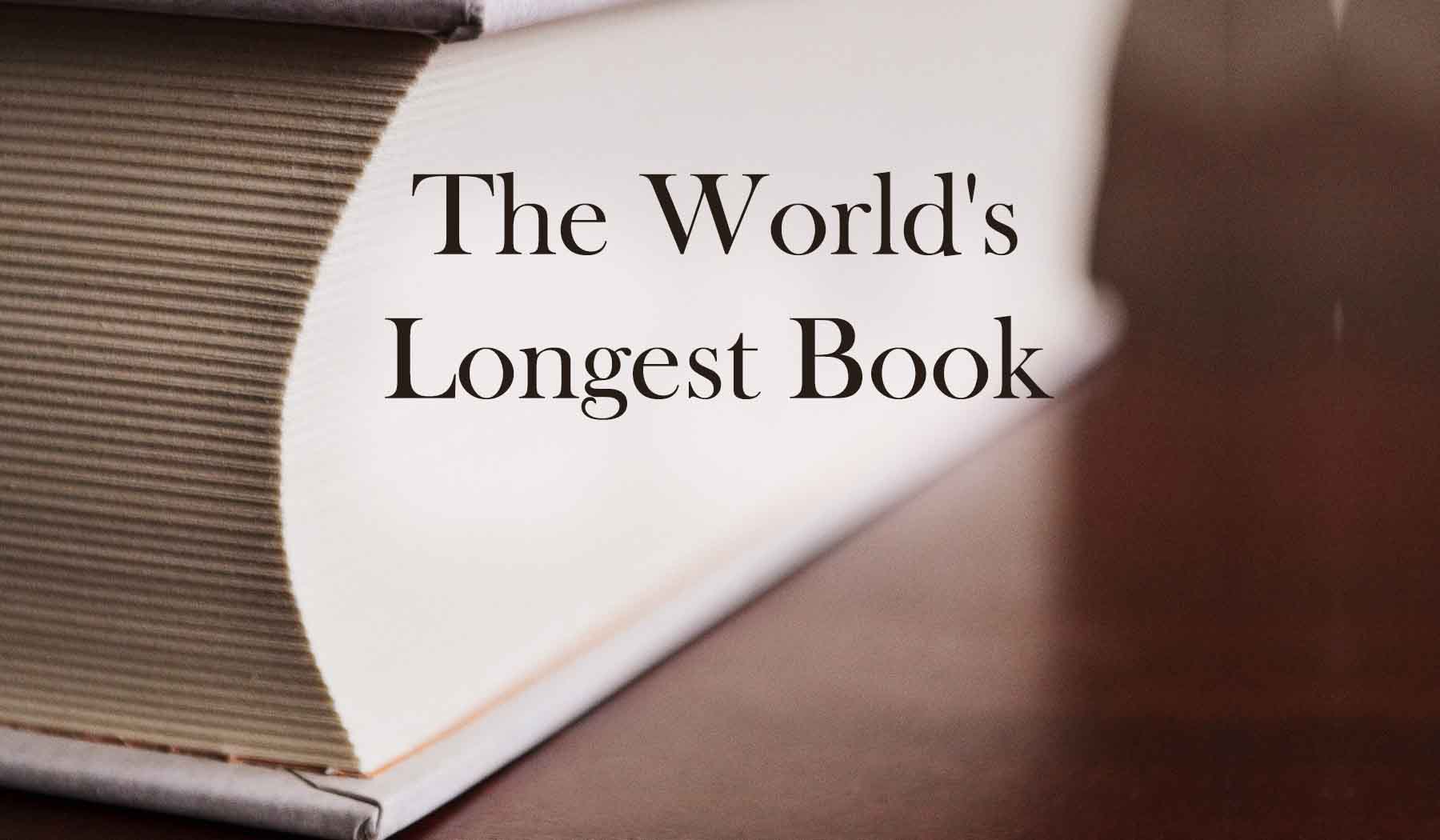When choosing a book to read, the length can be a significant factor for many readers. Some might hesitate to tackle books that fall into the category of the longest books in history, as they can be as massive as a brick, with thousands of pages.
Books come in various lengths, ranging from short stories to multi-volume epics. The length can be measured differently, such as counting the number of words or pages. Factors like font size and white space can also influence a book’s length.
While some readers may embrace lengthy tomes, others might prefer books of more manageable size to suit their reading pace and time constraints. Ultimately, the joy of reading lies in discovering captivating stories, regardless of length, as each written work offers a unique world to explore.
What is the Longest Book in the World?
The longest book in the world, as recognized by the Guinness World Records, is A la Recherche du temps Perdu, also known as Remembrance of Things Past, by Marcel Proust. This French novel was first published in 1913 and spanned seven volumes. It boasts an estimated total word count of 9,609,000.
A la recherche du temps perdu delves into intricate themes like memory, time, and consciousness, making it a significant literary work of the 20th century.
What Makes A la recherche du temps perdu So Long?
A la Recherche du temps perdu, also known as Remembrance of Things Past, holds the prestigious title of being the longest book in the world, according to the Guinness World Records. The total word count reaches 9,609,000, making it an unparalleled feat in literature.
At its core, A la recherche du temps perdu is an intricate exploration of memory, time, and human consciousness. Proust’s writing delves into the depths of the human psyche, examining the intricacies of our inner world and how past experiences shape our perceptions of the present. The novel’s narrative weaves through the remembrances of the protagonist, Marcel, as he embarks on a journey of self-discovery and introspection.
The Complexity and Significance of the Work
Proust’s novel is an artistic masterpiece and is widely regarded as one of the most important literary works of the 20th century. Its intricate prose, philosophical depth, and complex character development have captivated readers for generations. The novel’s exploration of human emotions and the nature of memory has resonated with audiences worldwide, making it a timeless and enduring piece of literature.
Challenging the Norms of Lengthy Literature
While A la recherche du temps perdu reigns as the undisputed champion of lengthy literature, other contenders have tried to claim the title. Among them is Mark Leach’s Marienbad My Love, boasting a jaw-dropping 17.8 million words. Nigel Tomm’s The Blah Story also has an impressive 11 million words.
However, it is essential to recognize that the sheer length of these books is not the sole indicator of their literary worth. Each work has its unique style, themes, and impact on readers. Lengthy texts challenge both authors and readers, as they demand a significant investment of time and commitment to explore their intricate narratives.
Publication Journey of Marcel Proust’s Masterpiece: A la Recherche du temps Perdu
Marcel Proust’s monumental literary achievement, A la recherche du temps perdu, commonly known as Remembrance of Things Past, is a captivating exploration of memory, time, and human consciousness. The inception of this literary masterpiece dates back to 1909 when Proust, at the age of 38, embarked on a writing journey that would forever reshape the landscape of modern literature.
The First Volume and Initial Challenges
After three years of meticulous writing, Proust completed the first volume of his magnum opus in 1912. Despite the brilliance of his work, he faced repeated rejections from various publishers and editors. Undeterred, Proust financed publishing the first volume through the Grasset publishing house in 1913. At this point, he envisioned only two additional books to complement the first.
Gaining Recognition and International Acclaim
Proust took a unique approach by paying critics to speak favorably about his book to ensure a favorable reception for his groundbreaking work. However, his efforts soon proved unnecessary as the novel’s second part received immediate international recognition and acclaim upon its release. The novel garnered prestigious awards and accolades, solidifying Proust’s position as a literary genius.
Continued Expansion and Enrichment
While Proust had initially established the structure of his novel, he continued to enrich and expand it even after completing volumes. During the tumultuous war years, he passionately revised and reworked his masterpiece, infusing it with profound emotions and intricate construction. This refinement process tripled the novel’s length, making it more immersive and impactful.
The Seven-Volume Publication Journey
Between 1913 and 1927, Proust’s epic work was released volume by volume, each installment captivating readers with profound insights into the human experience. Living a reclusive life in a sound-proofed flat in Paris, Proust devoted himself entirely to his writing, allowing his creative vision to unfold seamlessly across the seven volumes.
Posthumous Volumes
Proust’s dedication to his work persisted even as he faced health challenges. In November 1922, the literary world mourned the loss of this literary genius. While the first four volumes were meticulously completed, the last three contained oversights and unpolished passages in their draft form at Proust’s passing. His devoted brother Robert ensured that these posthumous volumes reached the public, editing and preserving Proust’s final artistic expressions.
Legacy of A la Recherche du temps Perdu
Marcel Proust’s A la Recherche du temps Perdu remains an enduring legacy in the world of literature. The novel inspires and enthralls readers across generations with its intricate portrayal of memory, profound character development, and masterful exploration of human emotions.
The journey of A la Recherche du temps Perdu is a testament to Marcel Proust’s dedication and artistic brilliance. His pursuit of literary perfection led him to create a timeless masterpiece that stands as a shining beacon of the power of words and the enduring impact of great literature.
Why Are These Books So Long?
In the vast world of literature, the length of a book can vary significantly, ranging from concise novellas to extensive multi-volume epics. Several factors contribute to the size of a book, and understanding these reasons can provide valuable insights into an author’s creative process and the diverse needs of readers.
- Ambitious Vision of the Author
Some books are long because the author has a grand and ambitious vision for the story they want to tell. They may seek to explore complex themes, develop intricate character arcs, and build detailed and immersive worlds. Authors with a penchant for rich storytelling often use lengthy narratives to realize their creative vision fully.
- Genre and Narrative Complexity
Specific genres naturally lend themselves to longer books. Epic fantasy novels, for instance, demand ample space to construct vast and intricate fictional realms with numerous characters and interconnected plotlines. Science fiction, historical fiction, and literary fiction are other genres that often benefit from extended storytelling to engage readers fully.
- Detailed World-Building
Books that delve into extensive world-building require substantial length to paint a comprehensive picture of their fictional universes. Authors invest time and effort in constructing intricate landscapes, societies, cultures, and histories to captivate readers and create a sense of authenticity.
- In-Depth Character Development
Lengthy books also allow for in-depth character development, enabling readers to connect strongly with the protagonists and supporting cast. Authors can explore characters’ motivations, emotions, and growth over time, adding depth and nuance to their stories.
- Complex Plot Structure
Books with complex and multi-layered plots often require more pages to unravel their intricacies fully. Authors may incorporate subplots, flashbacks, and multiple perspectives, necessitating a more extended narrative to tie everything together cohesively.
- Scholarly or Academic Works
Books aimed at an informed audience, such as academic research, historical analyses, or scientific treatises, often demand extensive content to present comprehensive findings and support their arguments thoroughly.
- Cultural and Historical Significance
Certain books acquire historical or cultural significance due to their extensive content. These works may hold substantial value in shaping societal discourse, preserving cultural heritage, or advancing essential ideas.
The length of a book is influenced by a combination of factors, from an author’s creative vision and narrative complexity to the demands of different genres and target audiences.
Critical Acclaim: A Modern Novel
A la Recherche du temps Perdu by Marcel Proust is hailed as a profound achievement of human imagination and a definitive modern novel. It offers a witty portrayal of French society during Proust’s time, featuring striking characters that leave a lasting impression. The novel’s impact on literature is immense, inspiring writers like Virginia Woolf and Samuel Beckett and garnering admiration from figures like Marilyn Monroe and Sean Connery. Despite some finding it challenging, A la Recherche du temps Perdu’s enduring legacy and influence on subsequent works solidify its place as a timeless classic exploring human emotions and the passage of time. Proust’s masterpiece continues to captivate readers worldwide.
Bottom Line
Long books, like A la Recherche du temps perdu and others, profoundly impact the world of literature. They challenge readers with their depth and complexity, inviting them to explore intricate narratives and philosophical themes. These epic works of fiction and nonfiction leave a lasting impression, shaping our understanding of human emotions, time, and consciousness.
As we venture into the future of literature, long books will hold a special place in readers’ hearts. They offer a rich, immersive experience that transports us to worlds beyond our own. While the publishing landscape may evolve with digital platforms and e-books, the allure of lengthy tomes remains unchanged.
Whether we embark on the literary journey of a lifetime or opt for shorter reads, let us celebrate the diversity and richness of books in all their forms. After all, the love of reading and the pursuit of knowledge unites us as readers, regardless of a book’s length. So, let us turn the pages and lose ourselves in the magic of words, knowing that every book, long or short, can inspire and transform our lives.










